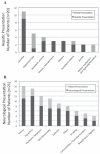Wilson disease: Canadian perspectives on presentation and outcomes from an adult ambulatory setting
- PMID: 22720274
- PMCID: PMC3378279
- DOI: 10.1155/2012/123431
Wilson disease: Canadian perspectives on presentation and outcomes from an adult ambulatory setting
Abstract
Background: Wilson disease (WD) is a rare disorder of copper metabolism.
Objective: To describe the authors' clinical experience with a cohort of 48 adult patients followed in an ambulatory setting.
Methods: A retrospective chart review of patients with a diagnosis of WD was performed.
Results: Fifty-nine charts were identified and 11 were excluded on further review. At diagnosis, 14 patients were asymptomatic, with 13 hepatic, 15 neurological and six mixed hepatic⁄neurological presentations. Ceruloplasmin levels were low (<0.20 g⁄L) in 94%, and 24 h urinary copper levels high (>0.60 µmol⁄L) in 95% of cases. D-penicillamine was the most common initial therapy (48%), with zinc the most common at review (65%). Overall, biopsy and ultrasound reports documented cirrhosis in 53%. Portal hypertension, defined as splenomegaly (>12.0 cm), reversed portal venous flow on ultrasound or varices⁄gastropathy on endoscopy was seen in 63%. At last review, 39% had elevated aspartate aminotransferase (>34 U⁄L) and⁄or alanine aminotransferase levels (>40 U⁄L). One death and one transplant occurred, while three patients had encephalopathy, two became jaundiced, two developed ascites and one experienced variceal bleed. Of 21 neurological presenting patients, 14 improved compared with baseline, with four making almost complete recovery. Eleven patients experienced documented episodes of neurological decline, including four with non-neurological presentation. Diagnostic magnetic resonance imaging showed basal ganglia (64%), brainstem (64%) abnormalities and atrophy (36%); follow-up showed basal ganglia lesions (50%) and atrophy (55%).
Conclusion: WD is a diverse chronic disease with generally favourable outcomes for patients who respond to initial therapy, which can be managed predominantly in an ambulatory setting.
HISTORIQUE :: La maladie de Wilson (MW) est un trouble rare du métabolisme du cuivre.
OBJECTIF :: Décrire l’expérience clinique des auteurs auprès d’une cohorte de 48 patients adultes suivis en milieu ambulatoire.
MÉTHODOLOGIE :: Les auteurs ont procédé à une analyse rétrospective des dossiers des patients ayant une MW diagnostiquée.
RÉSULTATS :: Les auteurs ont trouvé 59 dossiers, dont 11 ont été exclus lors de l’analyse. Au diagnostic, 14 patients étaient asymptomatiques, tandis que 13 avaient des manifestations hépatiques, 15, des manifestations neurologiques et six, des manifestations hépatiques et neurologiques mixtes. Le taux de céruloplasmine de 94 % d’entre eux était faible (moins de 0,20 g/L), et dans 95 % des cas, le taux de cuivre dans les urines sur 24 heures étaient élevés (plus de 0,60 μmol/L). La d-pénicillamine était le traitement initial le plus courant (48 %), et le zinc était le plus utilisé lors de la révision (65 %). Dans l’ensemble, les rapports de biopsie et d’échographie ont indiqué une cirrhose dans 53 % des cas. Les chercheurs ont constaté une hypertension portale, définie comme une splénomégalie (plus de 12,0 cm), un flux veineux portal rétrograde à l’échographie ou des varices ou une gastropathie à l’endoscopie dans 63 % des cas. À la dernière analyse, 39 % avaient des taux élevés d’aspartate-aminotransférase (plus de 34 U/L) ou d’alanine-aminotransférase (plus de 40 U/L), ou les deux. On a signalé un décès et une greffe, tandis que trois patients ont souffert d’une encéphalopathie, deux d’une jaunisse, deux d’ascites et un d’une hémorragie variqueuse. L’état de 14 des 21 patients ayant des manifestations neurologiques s’est amélioré par rapport aux données de départ, et quatre se sont presque entièrement rétablis. Onze patients ont vécu des épisodes étayés de déclin neurologique, dont quatre n’avaient pas de manifestations neurologiques. L’imagerie par résonance magnétique diagnostique a révélé des noyaux gris centraux (64 %), des anomalies du tronc cérébral (64 %) et une atrophie (36 %). Le suivi a révélé des lésions des noyaux gris centraux (50 %) et une atrophie (55 %).
CONCLUSION :: La MW est une maladie chronique diversifiée dont l’issue est généralement favorable chez les patients qui répondent à la thérapie initiale, et peut majoritairement être prise en charge en milieu ambulatoire.
Figures


References
-
- Roberts E, Schilsky M. Diagnosis and treatment of Wilson’s disease: An update. Hepatology. 2008;47:2089–111. - PubMed
-
- Chu NS, Hung TP. Geographic variations in Wilson’s disease. J Neurologic Sci. 1993;117:1–7. - PubMed
-
- Ferenci P, Caca K, Loudianos G, et al. Diagnosis and phenotypic classification of Wilson disease. Liver International. 2003;23:139–42. - PubMed
-
- Roberts EA, Robinson BH, Yang S. Mitochondrial structure and function in the untreated Jackson toxic milk (tx-j) mouse, a model for Wilson disease. Molecular Genet Metabol. 2008;93:54–65. - PubMed
-
- Institute of Statistics and Mathematics of the WU Wien The R Project for Statistical Computing. < http://www.r-project.org/> (Accessed April 2011).
MeSH terms
Substances
LinkOut - more resources
Full Text Sources
Medical
